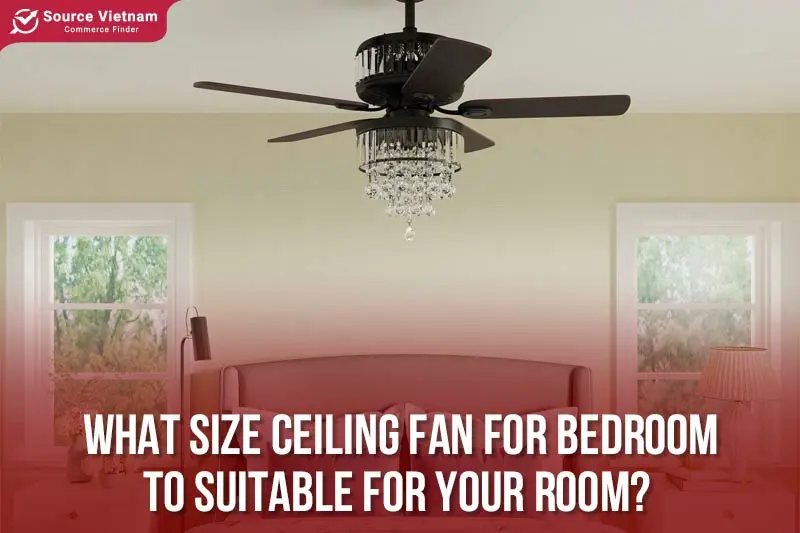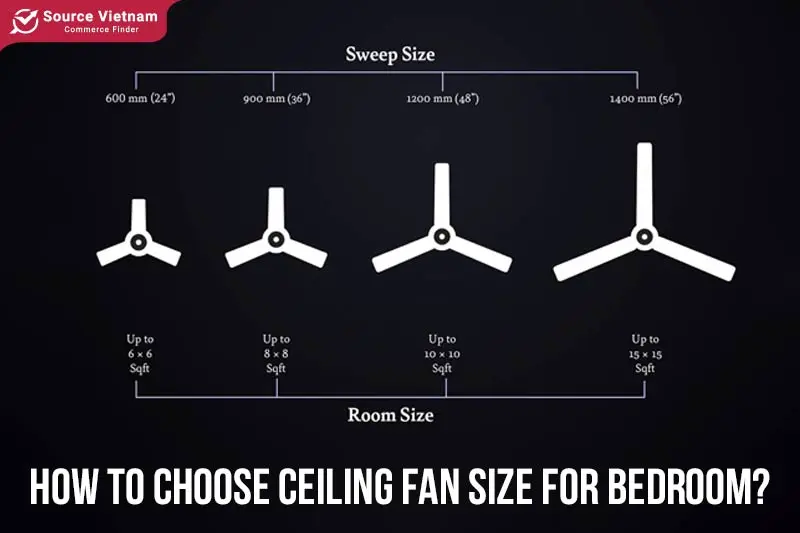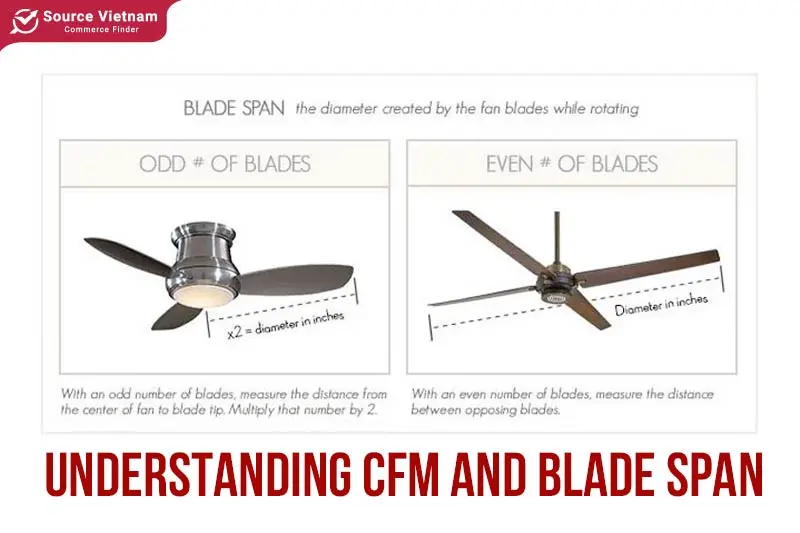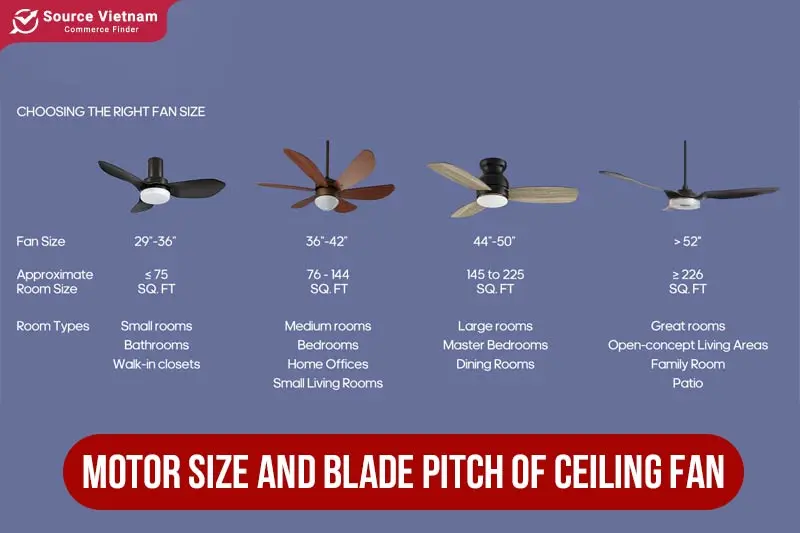A ceiling fan is a piece of furniture that brings a cool breeze to your bedroom. Unlike regular fans, when choosing a ceiling fan, you must consider more factors such as CFM (cubic feet per minute), fan blade span, and ceiling fan height. Let’s explore what size ceiling fan for bedroom and other factors to choose the best one for you.

Why does ceiling fan size matter?
A ceiling fan is a piece of functional and decorative furniture that adds beauty and elegance to your home. Choosing the right ceiling fan for wholesale bedroom furniture in the market is crucial as it is a unique and prominent piece of interior decor. Compared to other furniture, ceiling fans are large and mounted on the ceiling. Therefore, you need to be confident in your choice to avoid multiple installations, which can negatively impact the aesthetics of your ceiling.
Impact on airflow and comfort
Ceiling fans are designed to move a specific amount of air. Increasing the fan speed won’t increase that amount of air. Instead, the fan needs larger blades. At the same time, you don’t want a ceiling fan that’s too big for the space. Not only is it a waste of money, but the fan can also overwhelm the room.
For example, a 44-inch ceiling fan will move 3,600 to 3,700 cubic feet of air per minute. Installing one in a small room of 50 to 75 square feet means buying more air-moving capacity than you need. Plus, a 50-square-foot room, 5.8 feet by 8.6 feet, will have a large portion of the ceiling taken up by the ceiling fan.
Conversely, a small fan in a large room can’t move enough air to be effective. A 29-inch fan, or even one in the 29- to 36-inch range, would be more suitable for that space. After that, you can choose the best ceiling fan size for small bedroom.
Energy efficiency considerations
Choosing the right ceiling fan will help you optimize costs, save money, and conserve energy. When choosing a too small fan, it will have to work harder to cool the room, leading to higher energy consumption. You need to balance airflow and efficiency and choose the right size fan to provide enough airflow without consuming too much energy.
How to measure ceiling fan size?
First, you need to measure the room size and define your space. You only need to measure some basic parameters to understand the overall size, no need to measure in detail or too professionally. The parameters you need to measure:
- Length and width: measure with a tape measure and as accurately as possible to calculate the room area.
- Ceiling height: this parameter helps you determine the fan’s height, avoiding too low or too high.
- Distance from the ceiling to surrounding objects: pay attention to large objects such as chandeliers and wardrobes to ensure the fan does not affect them.

After measuring the parameters, you need to record them for accurate calculation, and they can be reviewed at any time. After calculating, you have a general overview and can now start considering the ceiling fan size guide.
Ceiling fan size guide chart
With your room measurements in hand, it’s time to delve into the world of ceiling fan specifications. Most manufacturers provide handy charts that match fan sizes to room dimensions. Here’s a sample table to understand how ceiling fans are measured:
| Fan size | Room size | Room type |
| Less than 29’’ | Less than 5×10 | Halfway, laundry room, walk-in closet |
| 39’’ | Up to 8×10 | Breakfast book, large bathroom |
| 42’’ | Up to 10×10 | Bedroom, office, kitchen |
| 52’’ | Up to 10×20 | Master bedroom, dining room, Patio Area |
| Greater than 56’’ | Up to 20×20 | Living room, Great room |
Besides the blade size, the fan height is also very important because it should not be too high or too low. Let’s look at the fan height chart according to the ceiling height:
| Ceiling height | Ideal downrod length |
| 8 feet | Standard |
| 9 feet | 12’’ downrod |
| 10 feet | 18’’ downrod |
| 11 feet | 24’’ downrod |
| 12 feet | 36’’ downrod |
| 13 feet | 48’’ downrod |
| 14 feet | 60’’ downrod |
| 15 feet and more | 72’’ downrod |
These two ceiling fan dimensions data tables provide valuable information to help you select the appropriate fan size for your needs. Based on the guidelines in these charts, you can easily determine the ideal size ceiling fan for a small bedroom.
Understanding CFM and blade span
To choose what size ceiling fan is for your bedroom, you should pay attention to the design, functionality, and blades for a suitable choice.
CFM (Cubic Feet per Minute)
CFM stands for Cubic Feet per Minute, which means the volume of air a ceiling fan can move in one minute. Simply put, CFM indicates the power of a ceiling fan.
The higher the CFM, the more powerful the fan and the more effective it is at cooling larger spaces. The lower the CFM, the weaker the fan, making it suitable only for small spaces or mild cooling requirements. However, it is necessary to balance CFM with energy efficiency. Factors affecting CFM: motor size, blade pitch, and blade span all contribute to a fan’s CFM rating.

When choosing a ceiling fan, CFM is an important factor to consider. It helps you:
- Choose the right fan size: A fan with the right CFM will ensure effective cooling for your room.
- Save energy: A fan that is too powerful for the room size will consume more energy than necessary.
- Ensure comfort: A fan that is too weak will not cool enough, while a fan that is too strong can cause discomfort.
How blade span affects airflow
Blade span is the distance between the tips of two opposite blades. This dimension significantly impacts a ceiling fan’s ability to generate airflow.
- Longer blade spans create a wider coverage area and move more air per rotation. This is beneficial for larger rooms that require powerful cooling.
- Shorter blade spans generate less airflow and are better suited for smaller spaces. The gentle breeze won’t make you feel too cold.
However, blade span is just one-factor affecting airflow. Other factors, such as motor power, blade pitch, and number of blades, also play important roles in determining a fan’s overall performance.
Choose the right motor size and blade pitch
Motor size and its impact on performance
By carefully considering the motor size and blade pitch, you can choose a ceiling fan that offers optimal performance, energy efficiency, and comfort for your space. When selecting a motor size, consider the following factors:
- Impact on performance: Larger motors mean more powerful fans, capable of moving more air and cooling larger spaces more effectively.
- Energy efficiency: Although powerful motors have many advantages, balancing performance and energy consumption is necessary. Consider choosing fans with energy-efficient motors to reduce electricity bills.
- Noise level: Larger motors can sometimes produce more noise. Consider the noise level when choosing a motor size, especially for bedrooms or quiet spaces.
Importance of blade pitch for optimal airflow
Blade pitch is the angle at which the blade is set relative to the plane of the fan. It directly affects the performance and airflow of a ceiling fan. A blade pitch between 12 and 15 degrees is typically suitable for most rooms. However, depending on the room size and your needs, you may choose a more suitable pitch.

- Impact on airflow: A higher blade pitch generates a stronger airflow but can also produce more noise. A lower pitch creates a gentler breeze.
- Ideal pitch: A blade pitch between 12 and 15 degrees is often considered ideal to balance airflow and noise levels. Also, this is the standard size ceiling fan for a bedroom.
- Room size: The ideal fan size blade pitch can vary depending on the room size. Larger rooms may require a higher pitch, while smaller rooms may be better suited for a lower pitch.
Choose your bedroom ceiling fan
Choosing a ceiling fan style is not just about cooling a space. It also contributes to creating a beautiful and personalized look for your room. Here are some suggestions to help you choose the most suitable ceiling fan:
- Determine your interior style: Choose a fan that matches your bedroom style. For example, a contemporary style should choose a fan with a simple design and neutral colors; a rustic style should choose a fan made of wood with a rustic design. Or a classic style with an elaborate design.
- Consider the color: The fan’s color should not be separate from the room’s overall color scheme or match the wall color. You can build a color palette for your bedroom and choose a suitable fan color.
In addition, you can choose other ceiling fan features, such as integrated LED lights, to decorate your bedroom.
Installation tips and safety guidelines
To ensure safety during installation and use, you need to follow these guidelines:

During the fan installation process
- Turn off the power: Always turn off the power at the main breaker before starting installation.
- Call an electrician: If unsure about electrical installation, consult a professional electrician.
- Follow the instructions: Strictly follow the installation instructions with the product.
- Ceiling joist: Ensure the fan is securely attached to the ceiling joist for durability.
- Electrical box: Use a dedicated electrical box for ceiling fans to ensure load capacity.
- Wiring: Connect the wires correctly according to the diagram included.
- Balance: Ensure the blades are balanced to avoid vibration.
- Height: Maintain a minimum distance of 2.1 meters between the blades and the floor.
- Clearance: Maintain at least 45cm (about 1.48 ft) of clearance between the blades, walls, or other obstacles.
Safe during operation
- Regular inspection: Regularly check screws, wires, and blades to ensure they are secure.
- Cleaning: Clean the fan regularly to remove dust.
- Maintenance: Perform maintenance according to the manufacturer’s schedule.
- Avoid direct contact: Do not attempt to stop the blades with your hands.
- Child safety: Keep the fan’s remote control out of the reach of children.
- Use fan support: For heavy fans, use support to increase durability.
- Adjust height: Use an extension pipe to adjust the fan’s height to suit high ceilings.
- Operational check: After installation, check the fan at all speeds to ensure smooth operation.
A comprehensive platform for retail and wholesale ceiling fans at the best prices
If you’re looking for ceiling fans to decorate your home but don’t know where to start or have little time to shop, SourceVietNam is the online e-commerce platform for you.
- Various designs and styles: From classic and elegant to modern and minimalist designs, you can easily find the perfect product for any living space, including living rooms, bedroom fan selections, restaurants, and cafes.
- Guaranteed quality: Sourcevietnam.com is committed to providing genuine ceiling fans with complete quality certification documents.
- Competitive pricing: We can offer the most competitive prices thanks to our direct connection with manufacturers.
- Professional customer service: Our experienced consultants are ready to assist you in selecting the most suitable product for your needs and space. You will enjoy a reliable warranty policy from both the manufacturer and Sourcevietnam.com.
SourceVietNam is a reliable destination for purchasing high-quality ceiling fans at affordable prices. With the benefits, you can confidently choose and use products from this platform.
Conclusion
Nowadays, many ceiling fan models have extremely sophisticated and beautiful designs. Through this ceiling fan size guide, we hope you clearly understand what size ceiling fan for bedroom and related technical specifications. And you can find ceiling fan products at the best wholesale prices on our Sourcevietnam platform. Explore now to buy the best furniture items for your bedroom.
FAQ about ceiling fan
What size ceiling fan for a 12×12 bedroom?
For a 12×12 bedroom, you’ll typically need a ceiling fan between 42 and 48 inches in diameter. This size range provides adequate airflow for a room of that size. This is also for the master bedroom. If the master bedroom is particularly spacious, you could consider a fan up to 60 inches or more for optimal air movement.
What size ceiling fan for a small bedroom?
For a small bedroom (around 10×10 feet or smaller), a ceiling fan with a blade span of 36 to 44 inches is generally recommended. This size provides adequate air circulation without overwhelming the room. A fan on the smaller end of that range (around 36 inches) would be more appropriate if the room is very small.
How high should a ceiling fan be installed in a bedroom?
A ceiling fan in a bedroom should be positioned between seven and nine feet above the ground. This series guarantees safety and ideal ventilation.
What is the most energy-efficient ceiling fan size?
The most energy-efficient ceiling fan size isn’t necessarily about the physical dimensions of the fan but rather the technology it uses.
Can a ceiling fan be too big for a bedroom?
It also depends on the size of the fan and your bedroom. For master bedrooms, a ceiling fan is a reasonable piece of furniture.















